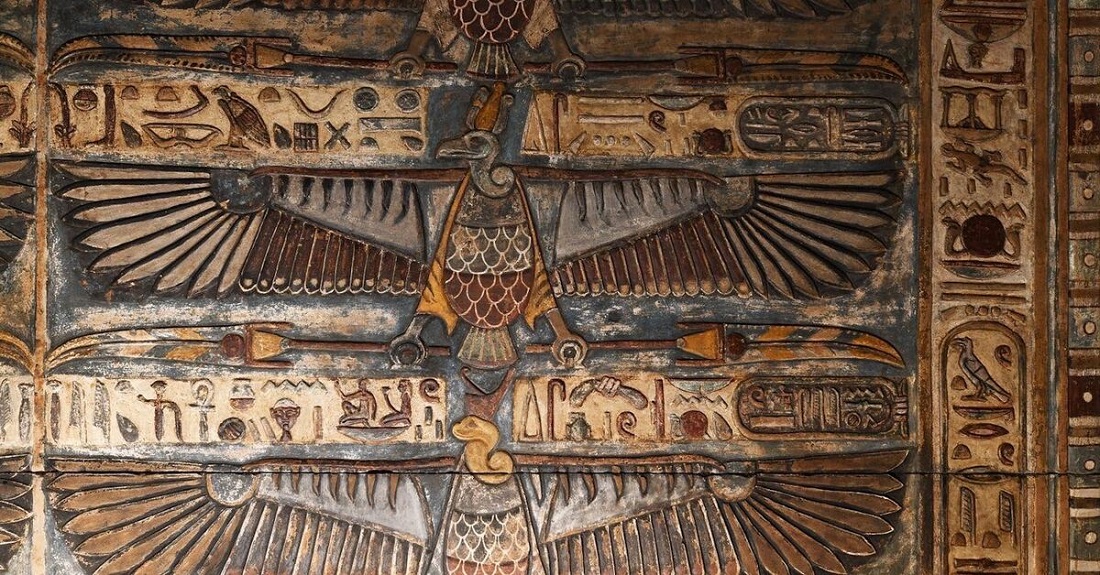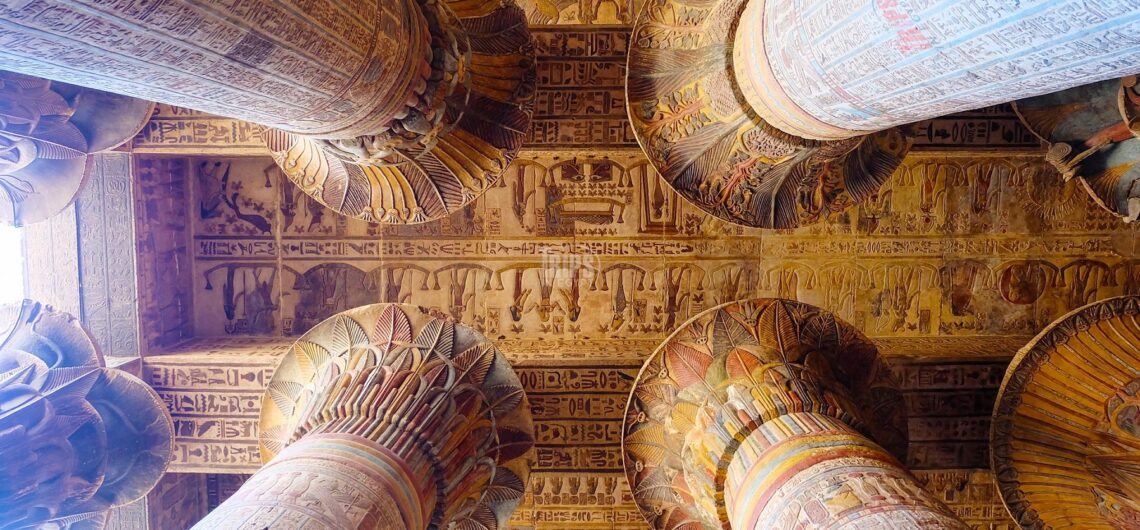Esna temple | Facts, History | Egyptian Monuments
Esna temple is one of the 6 majors of the Graeco-Roman Period (ca. 332 BCE – 350 CE) together with Philae temple, Kom Ombo, Edfu. Dendera, and Athribis. In fact, one of the best things to do in Luxor is visiting Esna temple. The temple has many unique features and, in this article, we clear the nomination of the city, the temple and the exceptional features found here.
We have many gods were worshipped side by side in the temple and the only representation for the emperor Septimius Severus and his family.
Esna Location
Esna city is located 58 km south of Luxor midway between Luxor and Edfu and it is famous with Esna Lock.
Nomination of Esna city
The city was the capital of the third Nome of upper Egypt and it had many names during the history
Iwnt means Heliopolis of Esna god
Ta Snt(i) means the seat of goddess Neith
Sni was the name in Coptic
Esna is the Arabic pronunciation of the Coptic word
T3 Hnt means the foremost of the earth
Latopolis in the Greco Roman Period means the town of the Lates fish (sacred fish of goddess Neith). Goddess Neith was described in Esna as the one who change her figure into the fish shape.
The Names of the temple
Hwt B3w means the temple of souls
Hwt It the temple of the father and her the father is Khnum
Moreover, Hwt Mut means the temple of the mother and they mean Neith
Also, Hwt Hnmu means the temple of Khnum
Esna Deities
Esna temple was consecrated mainly for two gods
Khnum and Neith
Khnum had two wives
Menhit the lioness headed deity
Nebetu like a leady with Hathoric crown two horns and the sun disc in between.
The Goddess Neith has no husband but she has two sons and always portrayed like a woman with red crown and holding the bow and the arrow
Shemannefer like a crocodile head man
Tutu always like a sphinx with human head
Esna Triad
Khnum, Nebetu, and Heka
Dating the temple
The existing temple dates back to the Greco Roman Period between 180 BC TILL 250 AD more than 400 years. But we should mention that the name of Thutmose III found two times in the pronaos. So, some scholars believe that the original temple dates back to the 18th dynasty, New Kingdom of Egypt.
The temple was rebuilt during the 26th dynasty because the name of Psamtik I was discovered.
The temple right now dates back to Ptolemy V, the son of Ptolemy IV and it was decorated by Ptolemy VI during his coregency with Ptolemy VIII and Cleopatra II.
Where is the Ptolemaic temple?
Unfortunately. The Ptolemaic temple almost disappeared except the west wall of the Pronaos. Esna temple was dismantled and its blocks were used by the inhabitants of the city as a building material for their houses.
Another opinion mentions that the temple was destroyed during the early Christianity because of the destroyed figures on the walls to announce the victory of Christianity over the Paganism.
The Roman temple
The pronaos was built during the Roman Period starting with Claudius, Tiberius, and the decoration started during the reign of Trajan, Antoninus Pius.
Who discovered Esna temple?
We have a graffiti date back to 1804 to a Scottish famous traveler John Jordan we found his name in Karnak, Habu temple and here engraved on the arm of one emperor. But the first one who unearthed the temple was Mohamed Ali Pacha in 1840 to use it like storage place for the Cotton and the Gun Powder.
The French expedition joined Napoleon between 1799-1801 they described the ceiling and the temple.
The French Egyptologist Jean François Champollion discovered inscriptions in 1828 that date from the time of King Thutmoses III
Description of Esna temple
Esna temple is 9 meters lower than the city right now and in front of the Pronaos there are two Coptic monasteries. Both monasteries date from the 4th century, the Monastery of Menabos and the Monastery of the Martyrs.
Entrance
The main entrance is located between 6 columns contain between them 6 screen walls plus two more subsidiary gateways.
The Hypostyle Hall | Pronaos
It measures 37*20 meters and 15 meters high with a roof supported by 18 columns. Also, there is a little room similar to that one in Edfu temple to store the wine, perfume, cultic tools. The walls are divided into 4 registers each and they contain 243 offering scenes.
The south part dedicated to Khnum while the Northern one to Neith.
The Screen Walls scenes
Right side
A Roman emperor receive the crowns from Horus like a falcon headed man and Thot as a phoenix headed man in the presence of Khnum and his wife Nebetu. Another scene for Monto and Atum gives the Ankh sign to nostrils of the king.
Left Side
Goddess Nekhbet and Wadjet coronate the emperor in front of Khnum. The second screen wall has a beautiful scene for Claudius between Horus and Thot purifying him in the presence of Menhit, leady wit lioness head.
Inside the Pronaos to the left side
There is a scene show the king Domitian sprinkling the sand in front of the god Khnum and Menhit.
Domitian one more time offer offerings to God Tutu in the shape of a sphinx with human head and Neith is setting.
Caracalla offers Khnum some offerings and burn incense in front of him
Domitian in a kneeling position offers Khnum and Nekhbet offerings
South wall
The Family of Septimius Severus when they visited Egypt and behind him his wife and his two sons Caracalla and Geta who was killed later by Caracalla in front of Khnum, Nebetu, Heka.
The Ptolemaic wall
Ptolemy VI Philometor killing the turtles the sign of darkness in front of Rahorakhty
Trajan dancing in front of Menhit and Nebetu to please them
North wall
Unique scene for Commodus catching fish, birds join by Horus, Khnum, Seshat.
Another very unique scene for the souls of Nekhen and Buto carrying Hadrian setting in a canopy
Outer walls
Domitian smiting the enemies in front of Khnum re and Menhit
Similar scene for Trajan in front of Neith and Khnum.
The ceiling

Very colorful ceiling decorated with Deans, Zodiac signs, Planets, Constellations, the wind. And certain deities.
Facts about Esna temple
- Building the existing temple took 400 years
- The capitals of the 24 columns of the Pronaos are totally different. There is no two alike
- The columns are not decorated with scenes but with texts
- Hieroglyphics signs appeared for the first time on the walls of this temple
- There are cartouches with the names of the Roman emperor came only here in the Egyptian shapes
- The god of the temple has two wives
- The legend of the destruction of human king is portrayed here
Opening hours of Esna temple
The Qaitbay Citadel is open daily between 08.00 am and 17.00 pm.
Esna temple entrance fee
You can purchase an Entrance ticket for the temple from the Ticket window which is by the entrance
Adult: EGP 200 (5 $)
Students with valid cards: EGP 100 (3 $)
Children aged 6-12 years: EGP 100 (3 $)
Children under 6 years: FREE


